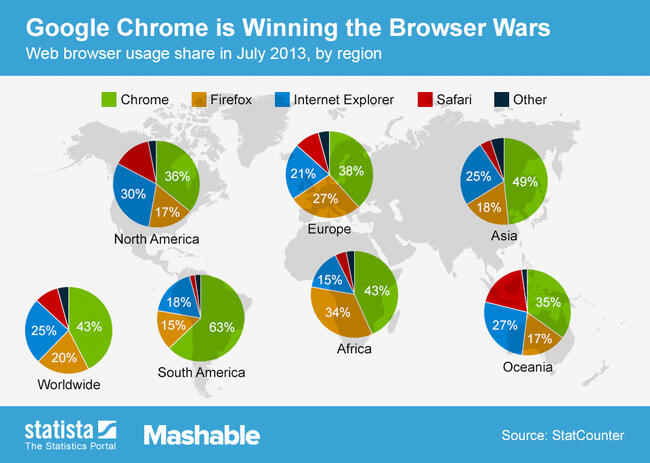http://www.statista.com/markets/21/internet/ Internet: market data and statistics
Among the following statistics about the internet you will find the most relevant and up-to-date statistical facts on this subject, including market data, market studies and other interesting facts relating to an array of internet topics.
Statistics from 2011 that deal with the global internet penetration rate stated that it reached 78.30 percent in North America. Australia followed with 60.10 percent, and Europe was in third place with 58.30 percent. With the highest penetration rate being in North America, a significant amount of statistical data showcases various aspects of internet usage in the USA; on the typical daily internet activities of US adult users, for example. In a study from 2010 these activities were separated by age groups:18-29 years old, 30-49, 50-64 and 65+. 60 percent of the 18-29 age group typically use the internet to visit social networking sites, another activity majorly associated with this age group is the sending and receiving of emails. This is also generally the activity group with the highest figures. The least popular internet activity is participating in an online auction.
Search engines have become a characteristic part of the online experience, offering users the opportunity to search for information and specific websites. Information on global search queries in search engines make for some exciting reading. In January 2012, Google had the largest global market share of leading search engines, topping the list at an impressive 91.53 percent. Statistics forecasting the data volume of internet traffic through email and web use (in petabytes per month) have predicted significant changes for 2015, with an effective doubling of the figure. It is expected to leap from its current 2012 figure: 4,146 in 2012 to 8,592 in 2015. One petabyte is equal to 1 million gigabytes.
Forecasts of the number of internet users worldwide depict rising figures as well. Between 2000 and 2010, the number of internet users has increased from 394 million to roughly 2 billion, which is almost a third of the world’s population.
The internet is generally defined as a system of globally interconnected computer networks. Network types can include public, private, academic, business, state, regional, national, international, etc. The main purposes the internet serves are considered to be providing users with information and means of communication. Statistics that deal with the in different countries therefore take on a new significance today.
To function, the internet depends on various technologies. Asnumbers of high speed internet customers in the United States demonstrate, the quality of the connection is of top priority for users. With the enormous expansion of social media and blogging websites in recent years, the internet has also become a major influence in the fields of social exchange and on social experiences, enabling fast and easy connection between people from all corners of the world.
Кой е номер 1 сред браузърите?
Най-често Google Chrome ползват потребителите в Южна Америка, Азия и Африка
Google Chrome е най-популярният интернет браузър в света, държейки 43% от глобалния пазар, съобщава "Машъбъл".
Данните от ново проучване сочат,че едва 36 процента от потребителите в родната на Google Северна Америка ползват Chrome, един от най-ниските резултати в световен мащаб. САЩ и Канада все още са бастион на Internet explorer (IE). Там браузърът на Microsoft заема цели 30%.
Както можете да се убедите от публикуваната по-долу графика най-силно е присъствието на Chrome в Южна Америка (63%), следвана от Азия (49%), Африка (43%) и Европа (38%).
Вторият по големина играч на полето на браузърите IE със световен пазарен дял от 25%. На трето място е Firefox на Mozilla (20%), сочат данните на statista.com


 East-Tec Eraser прекрасно се справя с премахването на всевъзможни следи от работата ви на компютъра, като в надеждността на изтриване на информацията надхвърля даже стандартните на Министерство на Отбраната на САЩ.
East-Tec Eraser прекрасно се справя с премахването на всевъзможни следи от работата ви на компютъра, като в надеждността на изтриване на информацията надхвърля даже стандартните на Министерство на Отбраната на САЩ. Coollector е програма, с която можете да организирате Вашата видео колекция. Програмата се състои от три основни категории: енциклопедия на филмите и артистите (повече от 50 000 филма и над 109 000 артисти); каталог, в който ще можете да организирате цялата си колекция с филми (DVD, VHS и т.н.), както и дадените назаем и взетите под наем филми; търсачка за купуване на филми, която автоматично търси възможно най-доброто предложение.
Coollector е програма, с която можете да организирате Вашата видео колекция. Програмата се състои от три основни категории: енциклопедия на филмите и артистите (повече от 50 000 филма и над 109 000 артисти); каталог, в който ще можете да организирате цялата си колекция с филми (DVD, VHS и т.н.), както и дадените назаем и взетите под наем филми; търсачка за купуване на филми, която автоматично търси възможно най-доброто предложение. TextAloud е програма за Text-To-Speech (TTS). Тя преобразува произволен текст, съдържащ се във файл в PDF, DOC или ТХТ формат в звук във формат WAV, MP3 или WMA. След стартиране се разполага в системния контейнер, като по този начин Ви осигурява бърз и лесен достъп до нея. Интегрира се с Internet Explorer. Разполага с прост и интуитивен многоезичен интерфейс и възможност за множество настройки.
TextAloud е програма за Text-To-Speech (TTS). Тя преобразува произволен текст, съдържащ се във файл в PDF, DOC или ТХТ формат в звук във формат WAV, MP3 или WMA. След стартиране се разполага в системния контейнер, като по този начин Ви осигурява бърз и лесен достъп до нея. Интегрира се с Internet Explorer. Разполага с прост и интуитивен многоезичен интерфейс и възможност за множество настройки.
